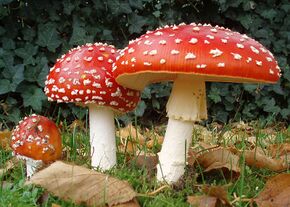Amanita muscaria
| Amanita muscaria | |
|---|---|
|
A. muscaria mushrooms in different stages of growth. |
|
| Taxonomical nomenclature | |
| Kingdom | Fungi |
| Phylum | Basidiomycota |
| Class | Agaricomycetes |
| Order | Agaricales |
| Family | Amanitaceae |
| Genus | Amanita |
| Species | A. muscaria |
| Common nomenclature | |
| Common names | Fly agaric, Fly amanita |
| Mycological Characteristics | |
| Spore print | White |
| Constituents | |
| Active constituents | Muscimol, Ibotenic acid |
Amanita muscaria (also known as fly agaric or fly amanita) is a semi-psychoactive mushroom that grows widely in the northern hemisphere; such as in the Boreal region. It is noted for its hallucinogenic properties, which are derived from its primary psychoactive constituents ibotenic acid and muscimol. Muscimol is a potent, selective agonist for the GABAA receptor that produces sedative, depressant and deliriant effects.[1]
Although classified as “poisonous”, reports of human deaths resulting from its ingestion are extremely rare. After parboiling—which weakens its toxicity and breaks down the mushroom's psychoactive substances[2]—it is eaten in parts of Europe, Asia, and North America.[citation needed]
Amanita muscaria has been used as an intoxicant and entheogen by the peoples of Siberia, and has a religious significance in these cultures. In western Siberia, the use of A. muscaria was restricted to shamans, who used it as an alternative method of achieving a trance state. In eastern Siberia, A. muscaria was used by both shamans and laypeople alike, and was used recreationally as well as religiously.[3]
There has been much speculation on possible traditional use of this mushroom as an intoxicant in other places such as the Middle East, Eurasia, North America, and Scandinavia.[citation needed]
In remote areas of Lithuania, Amanita muscaria has been reported to be consumed at wedding feasts. The Lithuanians have also been reported to export the mushrooms to the Lapps in the Far North for use in shamanic rituals.[4]
Amanita muscaria is sometimes confused with psilocybin mushrooms as "magic mushrooms". However, these two mushrooms have completely different active compounds, pharmacological effects, and appearances.
Habitat
Amanita muscaria has formed a symbiotic relationship with various coniferous and deciduous trees such as birches, pines, and spruces, and can often be found growing near them. There are many different varieties of Amanita muscaria with varying appearances.[5]
Chemistry
The principle psychoactive compounds in Amanita muscaria are muscimol and the related compound ibotenic acid. Both compounds have similar molecular structures; however, ibotenic acid contains a carboxyl group. Both compounds contain an isoxazole ring with a hydroxyl group bonded at the 3-position. Unlike muscimol, ibotenic acid is a non-selective glutamate receptor agonist, which contributes to its relatively powerful neurotoxic effects. Ibotenic acid is also decarboxylated to muscimol.
Amanita muscaria also contains small amounts of muscarine, a non-selective muscarinic acetylcholine receptor agonist. While this was once thought to be the principle mechanism of action of Amanita muscaria, it is no longer thought to be since the levels of muscarine are too low to be significant, and muscarine is unable to pass the blood-brain-barrier, meaning that muscarine is toxic, though not psychoactive.[6]
Pharmacology
Muscimol has an atypical mechanism of action. Unlike classical psychedelics (which are 5-HT2A agonists) and classical dissociatives (which are NMDA receptor antagonists), muscimol is a potent GABAA agonist, meaning it activates the receptor for GABA, the brain's principle inhibitory neurotransmitter. As an agonist, muscimol binds to the same site on the GABAA receptor as GABA itself. This is unlike benzodiazepines and barbiturates, which bind to different allosteric sites on the GABAA receptor.
Muscimol has also been shown to be a partial agonist at the GABAA-ρ receptor, which may contribute to its psychoactive effects. Activation of α1 subunit GABA receptors is responsible for the hallucinogenic effects of certain GABAergic compounds such as z-drugs, including zolpidem, and muscimol.[7]
The effects of isolated muscimol begin approximately one hour after consumption, peaking at 3 hours and lasting a total of 10-24 hours.[8]
Ibotenic acid has been shown to be a potent NMDA agonist as well as a powerful agonist at the group I and group II metabotropic glutamate receptors. Due to in vivo decarboxylation, ibotenic acid is metabolized to muscimol and thus has many similar pharmacological characteristics.
Subjective effects
Disclaimer: The effects listed below cite the Subjective Effect Index (SEI), an open research literature based on anecdotal user reports and the personal analyses of PsychonautWiki contributors. As a result, they should be viewed with a healthy degree of skepticism.
It is also worth noting that these effects will not necessarily occur in a predictable or reliable manner, although higher doses are more liable to induce the full spectrum of effects. Likewise, adverse effects become increasingly likely with higher doses and may include addiction, severe injury, or death ☠.
Physical effects 
-
- Sedation - Many users report mild to extreme sedation and even sleepiness while under the influence of amanitas.
- Stimulation - While most users report sedation and a lack of energy, some users also report a relatively intense stimulation.
- Spontaneous physical sensations
- Pain relief - Many users report a marked decrease in pain while under the influence.
- Muscle relaxation
- Muscle spasms
- Nausea
- Increased perspiration
- Pupil constriction
- Pupil dilation
- Increased salivation
Visual effects 
-
Enhancements
Suppression
Distortions
- Colour shifting
- After images
- Tracers
- Drifting
- Depth perception distortions
- Perspective distortions
- Recursion
Geometry
Hallucinatory states
- External hallucination (autonomous entities; settings, sceneries, and landscapes; perspective hallucinations and scenarios and plots)
- Internal hallucination (autonomous entities; settings, sceneries, and landscapes; perspective hallucinations and scenarios and plots)
- Transformations
- Peripheral information misinterpretation
Cognitive effects 
-
- Analysis enhancement
- Consciousness disconnection: Many users report a distinct dissociation from their surroundings while on Amanita muscaria.
- Cognitive euphoria - This results in feelings of physical euphoria which range between mild pleasure to powerfully all-encompassing bliss.
- Decreased libido or Increased libido - Many users of amanitas report to experience a noticeable decrease in libido while others report the opposite.
- Dream potentiation - Because of the sedating nature of Amanita muscaria, many people fall asleep before the prominent effects take effect. These individuals report extremely vivid and often lucid dreams.
- Empathy, love, and sociability enhancement - While this effect is less powerful than that of MDMA or MDA, it is still prominent.
- Sleepiness - As a GABAA agonist, the muscimol in Amanita muscaria can make people extremely drowsy.
- Anxiety suppression: Quite commonly people report profound anxiety suppression. That's due to the GABAergic activity triggered by muscimol.
- Anxiety: Anxiety is usually only present at high dosages.
- Unity and interconnectedness - While this effect is less powerful than that of MDMA or MDA, it is still prominent.
- Existential self-realization
- Existential conceptual thinking
- Immersion enhancement
- Increased music appreciation
- Analysis suppression
- Introspection
- Amnesia: This effect is usually only present at high doses.
- Memory suppression
Auditory effects 
-
- Auditory distortion
- Auditory hallucination - While a wide array of auditory hallucinations are possible, many users report hearing a strange, comforting, omnipresent humming sound.
Multi-sensory effects 
-
- Synesthesia: It's quite common to taste words or smell colors.
Experience reports
Anecdotal reports which describe the effects of this compound within our experience index include:
Additional experience reports can be found here:
Similar species

Hunting psychoactive mushrooms in nature can be very dangerous.
Caution is advised because poisonous or deadly mushrooms can easily be mistaken for edible ones.
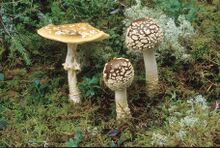 Amanita regalis - Psychoactive - This species contains ibotenic acid and muscimol. |
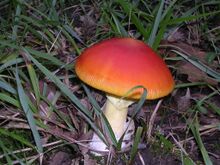 Amanita caesarea - Edible, but not recommended. |
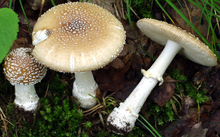 Amanita pantherina - Psychoactive - This species contains ibotenic acid and muscimol. |
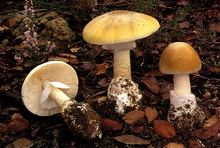 Amanita phalloides - Deadly - This species contains α-amanitin and β-Amanitin which has lead to numerous deaths. |
Toxicity and harm potential

It is important to convert ibotenic acid to muscimol before consumption.
Please read Fly agaric: Ibotenic acid decarboxylation to muscimol to learn how to convert the relatively neurotoxic compound (speculated to be a stimulant[9][10]) ibotenic acid to muscimol.
Also, novel edibles "Amanita Mushroom Gummies" contain a substantial amount of ibotenic acid along with muscimol and muscarine. Given the toxicity of ibotenic acid, the consumption of those preparations even in small doses should be avoided![11]
A 1998 publication listed Muscimol as an Extremely Hazardous Substance (EHS) on the Environmental Protection Agency's (EPA) list. However, a later document from 2006 shows it was removed from the list.
The LD50 of muscimol in rat is 45mg/kg orally and in mice is 20mg/kg orally.[12]
Since muscimol and ibotenic acid are GABAA agonists, it may be harmful to combine it with other GABAergic depressants such as benzodiazepines or barbiturates. Ibotenic acid is also known to be a neurotoxin, acting via the NMDA receptor and metabotropic glutamate receptor. It is wise to dry amanitas in the oven or purchase pre-dried amanitas to ensure the ibotenic acid concentration is as low as possible.
One of the major dangers of Amanita muscaria is misidentifying it as a different species of mushroom. Several other mushrooms in the genus amanita are toxic. One such mushroom, the Amanita phalloides, better known as the death cap, contains α-amanitin and β-Amanitin, both of which are extremely potent RNA polymerase II and RNA polymerase III inhibitors which damage virtually every tissue in the body. As the name suggests, the Amanita muscaria contains the chemical muscarine, a muscarinic acetylcholine agonist which is known to cause seizures; however, the mushroom contains very low amounts that are highly unlikely to pose any significant harm.
Amanita muscaria mushrooms are not known to be addictive or dependence-forming, and reports even show that desire to redose goes down with usage, though there is no research on this topic.
It is strongly recommended that one use harm reduction practices when using this substance.
Legal status
Amanita muscaria grows naturally and is legal to grow, sell and consume in most parts of the world. It is, however, restricted in some countries.
- Australia: The muscimol present in Amanita muscaria is considered a Schedule 9 prohibited substance in Australia under the Poisons Standard (October 2015).[13] A Schedule 9 substance is a substance which may be abused or misused and the manufacture, possession, sale or use of is prohibited by law except when required for medical or scientific research, or for analytical, teaching or training purposes with approval of Commonwealth and/or State or Territory Health Authorities.[13]
- Netherlands: Amanita muscaria and Amanita pantherina are illegal to buy, sell, or possess since December 2008. Possession of amounts larger than 0.5 g dried or 5 g fresh lead to a criminal charge.[14]
- United Kingdom: It is illegal to produce, supply, or import this drug under the Psychoactive Substance Act, which came into effect on May 26th, 2016.[15]
See also
External links
- Amanita muscaria (Wikipedia)
- Psychoactive Amanita mushroom (Wikipedia)
- Legal status of psychoactive Amanita mushrooms (Wikipedia)
- Psychoactive amanitas (Erowid)
- Amanita muscaria (Drugs-Forum)
- Amanitaceae.org
- Tatiana Urkachen, A Siberian shaman explaining A. muscaria (Youtube)
- https://www.reddit.com/r/AmanitaMuscaria/
References
- ↑ Frolund, B., Ebert, B., Kristiansen, U., Liljefors, T., Krogsgaard-Larsen, P. "GABA-A Receptor Ligands and their Therapeutic Potentials". Current Topics in Medicinal Chemistry. 2 (8): 817–832.
- ↑ Rubel, W., Arora, D. (November 2008). "A Study of Cultural Bias in Field Guide Determinations of Mushroom Edibility Using the Iconic Mushroom, Amanita muscaria, as an Example". Economic Botany. 62 (3): 223–243. doi:10.1007/s12231-008-9040-9. ISSN 0013-0001.
- ↑ Nyberg, H. (1992). "Religious use of hallucinogenic fungi: A comparison between Siberian and Mesoamerican cultures". Karstenia. 32 (2): 71–80. doi:10.29203/ka.1992.294. ISSN 0453-3402.
- ↑ Wasson, R. G. (1980). The wondrous mushroom: mycolatry in Mesoamerica. McGraw-Hill. ISBN 9780070684423.
- ↑ Fuhrer, B. A. (2005). A Field Guide to Australian Fungi. Bloomings Books. ISBN 9781876473518.
- ↑ Pavlov VA, Ochani M, Gallowitsch-Puerta M, Ochani K, Huston JM, Czura CJ, Al-Abed Y, Tracey KJ. Central muscarinic cholinergic regulation of the systemic inflammatory response during endotoxemia. Proc Natl Acad Sci U S A. 2006 Mar 28;103(13):5219-23. doi: 10.1073/pnas.0600506103. Epub 2006 Mar 20. PMID: 16549778; PMCID: PMC1405626.
- ↑ Geng H.Y., et al. Erbb4 deletion from medium spiny neurons of the nucleus accumbens core induces schizophrenia-like behaviors via elevated GABAAR α1 expression. Journal of Neuroscience. 2017, 37(31):7450-7464. PubMed ID: 28667174
- ↑ Hollister, Leo E. (1990). "New class of hallucinogens: GABA-enhancing agents". Drug Development Research. Wiley. 21 (3): 255. doi:10.1002/ddr.430210311. ISSN 0272-4391.
- ↑ Chilton 1975; Theobald et al. 1968
- ↑ Chilton 1975; Ott 1976a
- ↑ https://www.kykeonanalytics.com/news/New-trend-of-Amanita-Mushroom-Gummies-potentially-neurotoxic-edibles/
- ↑ https://www.caymanchem.com/msdss/13667m.pdf
- ↑ 13.0 13.1 "Poisons Standard October 2015". Federal Register of Legislation.
- ↑ "wetten.nl - Regeling - Opiumwet - BWBR0001941". wetten.overheid.nl (in Dutch).
- ↑ Psychoactive Substances Act 2016
